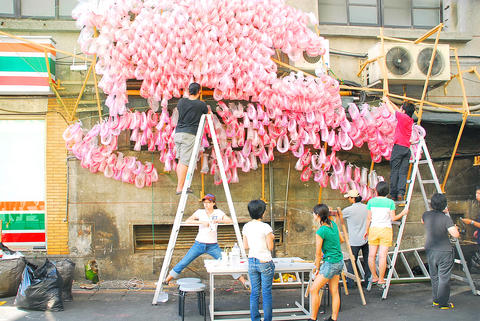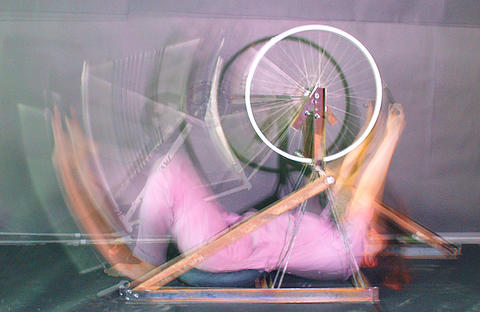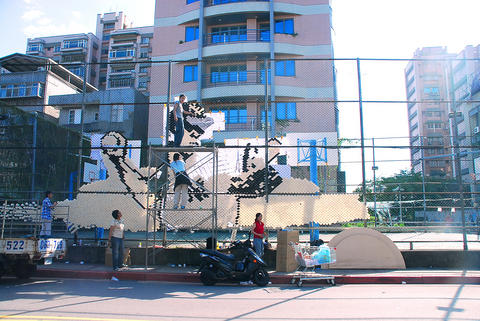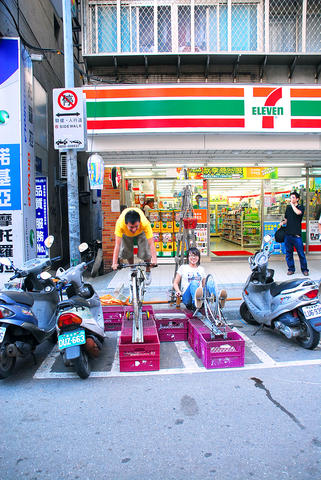Walking around the Mingde (明德) MRT station or National Taiwan University campus (國立台灣大學), you might notice a strange trend in unused, public spaces near 7-Elevens. Along Dingzhou Road (汀州路), there is a posterized image of baseball hero Wang Jian-ming (王建明), for example. It is made from paper cups inserted in a wire fence; further down, motorcycle parking spaces have been blocked off with milk crates and contraptions made from disused bicycles adorn the sidewalk.
"You're not really meant to see them until you come upon them," said Tseng Wei (曾瑋), an architect from Taichung who also teaches at the College of Design at the Shih Chien University (實踐大學). "It is supposed to inspire a new way of looking at how urban space can be used." There is a handbook hanging from a nearby signpost describing how the sculptures, which look like dangerous gym equipment, can be used.
This installation is one of eight that is part of a project called 7-Eleven City: Poetry, Architecture, New Communities, funded in part by the President Chain Store Corp (統一超商) - parent company of 7-Eleven. The project teamed four foreign and four local architects with eight poets to create eight installations. Part of the challenge was that although the individual 7-Eleven stores which serve as markers for the installations were all participants, architects had to liaise with the community as well.

PHOTOS: COURTESY OF SHIH CHIEN UNIVERSITY
Information about the location of the eight projects can be found in participating 7-Eleven stores. Installations are meant to remain in place until next weekend, but some are likely to fall victim to the elements or local residents.
Circle of Hope, just outside Mingde MRT station, created from massive blocks of ice by Taipei architect Lien Hao-yen (連浩延), unsurprisingly did not survive the first day.
Marco Casagrande, a Helsinki-based architect who is currently a visiting professor at Tamkang University (淡江大學), found that his Finnish sauna was not uniformly appreciated by local residents. There were complaints about the smoke from the wood fire.

"The project raised issues of how we perceive public space," said Ruan Ching-yue (阮慶岳), one of the project's organizers. An army of scarecrows that stand half-hidden on Wenzhou Street (溫州街) required permission from local shop owners. "People here are always willing to go for it," Casagrande said. "I think there would be much more resistance in the US or Europe to a project like this."
For Beijing-based architect Wang Yun (王昀), it is the multiplicity of networks in which we now live that gave interest to the project. "7-Elevens are everywhere, and form a network which we negotiate when moving through the community. Mobile phones are another. Internet another. There are layers of networks which we are negotiating constantly. A project like this helps architecture students and the public become more aware of the networks in which they are enmeshed."



Even by the standards of Ukraine’s International Legion, which comprises volunteers from over 55 countries, Han has an unusual backstory. Born in Taichung, he grew up in Costa Rica — then one of Taiwan’s diplomatic allies — where a relative worked for the embassy. After attending an American international high school in San Jose, Costa Rica’s capital, Han — who prefers to use only his given name for OPSEC (operations security) reasons — moved to the US in his teens. He attended Penn State University before returning to Taiwan to work in the semiconductor industry in Kaohsiung, where he

On May 2, Chinese Nationalist Party (KMT) Chairman Eric Chu (朱立倫), at a meeting in support of Taipei city councilors at party headquarters, compared President William Lai (賴清德) to Hitler. Chu claimed that unlike any other democracy worldwide in history, no other leader was rooting out opposing parties like Lai and the Democratic Progressive Party (DPP). That his statements are wildly inaccurate was not the point. It was a rallying cry, not a history lesson. This was intentional to provoke the international diplomatic community into a response, which was promptly provided. Both the German and Israeli offices issued statements on Facebook

May 18 to May 24 Pastor Yang Hsu’s (楊煦) congregation was shocked upon seeing the land he chose to build his orphanage. It was surrounded by mountains on three sides, and the only way to access it was to cross a river by foot. The soil was poor due to runoff, and large rocks strewn across the plot prevented much from growing. In addition, there was no running water or electricity. But it was all Yang could afford. He and his Indigenous Atayal wife Lin Feng-ying (林鳳英) had already been caring for 24 orphans in their home, and they were in

Australia’s ABC last week published a piece on the recall campaign. The article emphasized the divisions in Taiwanese society and blamed the recall for worsening them. It quotes a supporter of the Taiwan People’s Party (TPP) as saying “I’m 43 years old, born and raised here, and I’ve never seen the country this divided in my entire life.” Apparently, as an adult, she slept through the post-election violence in 2000 and 2004 by the Chinese Nationalist Party (KMT), the veiled coup threats by the military when Chen Shui-bian (陳水扁) became president, the 2006 Red Shirt protests against him ginned up by